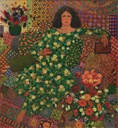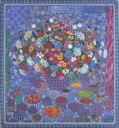Jeanne Leighton Lundberg Clarke
(Alpena, Michigan, 1925 - 2014, Provo, Utah)
Jeanne Clarke was born in Alpena, Michigan. When she was very young, her family moved to Wyoming, Ohio, a suburb of Cincinnati. Clarke began her artistic training in Chicago, Illinois, where she studied simultaneously at the University of Chicago and at the Chicago Art Institute. Clarke married at the age of 19 and settled in Connecticut, where she raised three children. While there, she resumed her artistic training, taking private lessons and studying at the Silvermine Guild and at Yale University. A convert to the Church of Jesus Christ of Latter-day Saints, Clarke wanted to study and better understand her religion. To accomplish this, at the age of 50, she decided to move to Utah and attend Brigham Young University. In five years she earned both her Bachelor of Fine Arts and Master of Fine Arts degrees. After graduating, Clarke began teaching drawing and painting at Brigham Young University. Jeanne Leighton-Lundberg Clarke is a symbolist; her paintings contain symbols and metaphors that have multiple meanings. Clarke developed her personal style through trial and error, experimenting with Abstraction and Expressionism but finally settling with Realism. Although Jeanne uses Colorfield, Op Art, and Post-Impressionist techniques, she feels her paintings would be meaningless without people. "When you get right down to it, " she says, "people are what it's all about . . . All moments are special. The present moment is all that we have and if we treat each moment, each day, as if it is special, then we are living life to the fullest." Clarke also considers herself a "maximalist" (an artist who fills every area of the canvas with detailed imagery) because she saturates every inch of the canvas with symbols. She explains, "We are jugglers, trying to be mothers, career women, lovers, housekeepers,the overextended all-around handywoman. We pray that our humor holds up, and that time allows us some pleasure and some freedom to express ourselves. Minimalist art, or non-representational art consisting chiefly of geometric shapes and forms, certainly cannot symbolize a woman's experience." Intricate and varied, the motifs in Clarke's paintings reflect her philosophy that life is abundant and complex, filled with hidden meanings waiting to be explored. "Everything that is created has a pattern," she notes. "There's a genetic code which seals patterns into us and there are those patterns we have chosen to invite into our lives. Life's events have patterns as well. Our routines are patterns. In my paintings I put patterns over patterns and they become textural. I invite the viewer to sort out the patterns, as in life." Clarke's style expresses concern about the fundamental importance of women and the family in society. Matriarch of both her own family and her extended family of aspiring student artists, she portrays positive moments of times when family and friends gather together. Her canvases of interior scenes, such as Entertaining Favorite Ladies II, and The Earth is full of the Goodness of the Lord, are usually large and filled with objects of daily existence. Just as in these pieces, most of her paintings have a table in the foreground, abundantly overflowing with decorative containers, floral bouquets, and bowls of fruits and nuts. Symbolically, the table represents the earth and the variety and plentitude of all the good things of life. The containers are visual metaphors for events, surprises, and happenings of human experience. Entertaining: Favorite Ladies II uses portraits of women painted by famous artists as symbolic guests at the artist's table. Each guest represents an artist who has affected Clarke's own artistic development. - Identification of individuals, clockwise from top center: Vincent Van Gogh: Augustine Roulin (La Berceuse), 1889 (oil, 36-5/8" x 28-3/4" Art Institute of Chicago) Andy Warhol: Marilyn Monroe, 1962 (silkscreen, Brigham Young University, Provo) Pierre-Auguste Renoir: La Loge, 1874 (oil, Courtauld Collection, London) Jan Vermeer: Girl In a Turban, 1660's (oil, 18-1/4" x 15-1/2") Jeanne Leighton-Lundberg Clarke: Self-portrait of artist Jean Baptiste Camille Corot: Woman with a Pearl , 1912 (oil, 27-1/2" x 21" Louvre, Paris) Willem DeKooning: Woman I , 1950-1952 (oil , 76"x 58" Museum of Modern Art, New York) Unknown Egyptian: Queen Nefertari in Adoration, 1290-1220 B.C. (fresco-relief, Tomb of Nefertari Deir el-Medineh, Valley of the Queens, Egypt ) Pierre Bonnard: Woman with a Striped Tablecloth, 1921 (oil, 23-1/4"x 30" Private Collection) Edgar Degas: Dancers, 1899 (pastel, 20 x25-1/8" The Toledo Museum of Art , Toledo, Ohio) Edouard Manet: Luncheon on the Grass, 1863 (oil, 7'-3/4" x 8'10-3/8" Musee d'Orsay, Paris) Pablo Picasso: Girl Before a Mirror, 1932 (oil, 5'3-3/4" x 4' 3-1/2" Museum of Modern Art, New York) Henri Matisse: Odalisque with a Red Coat, 1937 (oil, 55 x 46 cm Private Collection) Rembrandt van Rijn: Hendrickje Stoffels, (oil, Louvre, Paris) Eugene Delacroix: Orphan Girl in the Graveyard, 1823 (oil, National Gallery, London)
(Alpena, Michigan, 1925 - 2014, Provo, Utah)
Jeanne Clarke was born in Alpena, Michigan. When she was very young, her family moved to Wyoming, Ohio, a suburb of Cincinnati. Clarke began her artistic training in Chicago, Illinois, where she studied simultaneously at the University of Chicago and at the Chicago Art Institute. Clarke married at the age of 19 and settled in Connecticut, where she raised three children. While there, she resumed her artistic training, taking private lessons and studying at the Silvermine Guild and at Yale University. A convert to the Church of Jesus Christ of Latter-day Saints, Clarke wanted to study and better understand her religion. To accomplish this, at the age of 50, she decided to move to Utah and attend Brigham Young University. In five years she earned both her Bachelor of Fine Arts and Master of Fine Arts degrees. After graduating, Clarke began teaching drawing and painting at Brigham Young University. Jeanne Leighton-Lundberg Clarke is a symbolist; her paintings contain symbols and metaphors that have multiple meanings. Clarke developed her personal style through trial and error, experimenting with Abstraction and Expressionism but finally settling with Realism. Although Jeanne uses Colorfield, Op Art, and Post-Impressionist techniques, she feels her paintings would be meaningless without people. "When you get right down to it, " she says, "people are what it's all about . . . All moments are special. The present moment is all that we have and if we treat each moment, each day, as if it is special, then we are living life to the fullest." Clarke also considers herself a "maximalist" (an artist who fills every area of the canvas with detailed imagery) because she saturates every inch of the canvas with symbols. She explains, "We are jugglers, trying to be mothers, career women, lovers, housekeepers,the overextended all-around handywoman. We pray that our humor holds up, and that time allows us some pleasure and some freedom to express ourselves. Minimalist art, or non-representational art consisting chiefly of geometric shapes and forms, certainly cannot symbolize a woman's experience." Intricate and varied, the motifs in Clarke's paintings reflect her philosophy that life is abundant and complex, filled with hidden meanings waiting to be explored. "Everything that is created has a pattern," she notes. "There's a genetic code which seals patterns into us and there are those patterns we have chosen to invite into our lives. Life's events have patterns as well. Our routines are patterns. In my paintings I put patterns over patterns and they become textural. I invite the viewer to sort out the patterns, as in life." Clarke's style expresses concern about the fundamental importance of women and the family in society. Matriarch of both her own family and her extended family of aspiring student artists, she portrays positive moments of times when family and friends gather together. Her canvases of interior scenes, such as Entertaining Favorite Ladies II, and The Earth is full of the Goodness of the Lord, are usually large and filled with objects of daily existence. Just as in these pieces, most of her paintings have a table in the foreground, abundantly overflowing with decorative containers, floral bouquets, and bowls of fruits and nuts. Symbolically, the table represents the earth and the variety and plentitude of all the good things of life. The containers are visual metaphors for events, surprises, and happenings of human experience. Entertaining: Favorite Ladies II uses portraits of women painted by famous artists as symbolic guests at the artist's table. Each guest represents an artist who has affected Clarke's own artistic development. - Identification of individuals, clockwise from top center: Vincent Van Gogh: Augustine Roulin (La Berceuse), 1889 (oil, 36-5/8" x 28-3/4" Art Institute of Chicago) Andy Warhol: Marilyn Monroe, 1962 (silkscreen, Brigham Young University, Provo) Pierre-Auguste Renoir: La Loge, 1874 (oil, Courtauld Collection, London) Jan Vermeer: Girl In a Turban, 1660's (oil, 18-1/4" x 15-1/2") Jeanne Leighton-Lundberg Clarke: Self-portrait of artist Jean Baptiste Camille Corot: Woman with a Pearl , 1912 (oil, 27-1/2" x 21" Louvre, Paris) Willem DeKooning: Woman I , 1950-1952 (oil , 76"x 58" Museum of Modern Art, New York) Unknown Egyptian: Queen Nefertari in Adoration, 1290-1220 B.C. (fresco-relief, Tomb of Nefertari Deir el-Medineh, Valley of the Queens, Egypt ) Pierre Bonnard: Woman with a Striped Tablecloth, 1921 (oil, 23-1/4"x 30" Private Collection) Edgar Degas: Dancers, 1899 (pastel, 20 x25-1/8" The Toledo Museum of Art , Toledo, Ohio) Edouard Manet: Luncheon on the Grass, 1863 (oil, 7'-3/4" x 8'10-3/8" Musee d'Orsay, Paris) Pablo Picasso: Girl Before a Mirror, 1932 (oil, 5'3-3/4" x 4' 3-1/2" Museum of Modern Art, New York) Henri Matisse: Odalisque with a Red Coat, 1937 (oil, 55 x 46 cm Private Collection) Rembrandt van Rijn: Hendrickje Stoffels, (oil, Louvre, Paris) Eugene Delacroix: Orphan Girl in the Graveyard, 1823 (oil, National Gallery, London)




